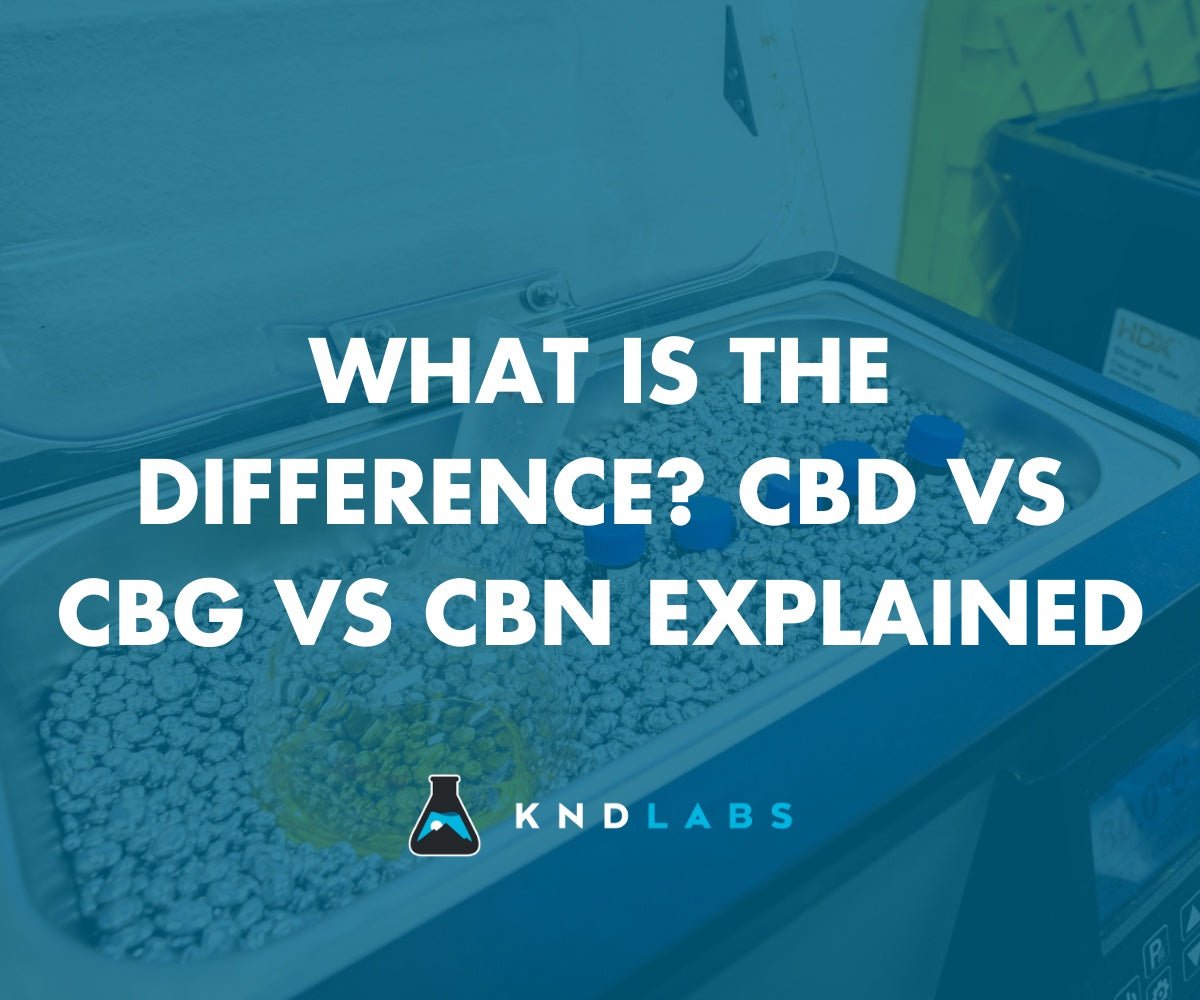
When you’re browsing shelves for a natural remedy from hemp, there can be a dizzying number of letter combinations at your disposal. Between CBD vs CBG vs CBN (okay, maybe only three), it’s easy to lose sight of their different purpose and potential benefits.
KND Labs is here to help you make an informed decision. Here’s our expert breakdown of CBD, CBG, and CBN, and the important distinctions between them. Please note that none of the information below is to be used as label claims, as the research provided here is supported by third-party studies independent of KND Labs.
What is CBD?
CBD, also known as cannabidiol, is a naturally occurring chemical compound found in hemp. It’s the second most available substance in the plant, making it one of the easiest (and most affordable) to extract and distill from CBD flower.
CBD was first discovered and isolated in 1940 by Roger Adams, then identified structurally in 1964 by an Israeli scientist. Since then, the compound has dominated the market and is sold legally in products like CBD oil, CBD drinks, and CBD gummies everywhere from grocery stores to gas stations.
The chemical is non-psychoactive and comes from hemp, meaning that it doesn’t produce a buzz or “high.”
Potential therapeutic effects of CBD
Between CBD, CBG, and CBN, scientists have devoted the most time and effort to studying CBD’s potential healing properties and health benefits.
Research has shown that CBD can be effective for:
- Alleviation of chronic pain
- Treatment of nausea and vomiting
- Treatment of multiple sclerosis spasticity symptoms
People also generally accept CBD as an anti-inflammatory, anti-insomnia, and anxiety-reducing compound, although less concrete evidence exists. It has been used to treat seizures from a rare genetic disease and studied as a blocker against the cravings that cause addiction.
What is CBG?
CBG, also known as cannabigerol, is known as the “mother” of the other hemp chemicals and the first compound created as the plant develops. When the plant flowers, CBG converts into the plant’s other substances through a reaction to ultraviolet light and heat.
CBG also occurs in low concentrations and is typically expensive to extract. It’s also derived from hemp, making it legal in the US.
Similarly to CBD, CBG is non-psychoactive and doesn’t produce any mind-altering effects.
Potential therapeutic effects of CBG
Because it’s rarer than CBD, scientists have spent less time researching CBG’s positive benefits. That being said, preliminary research has positioned CBG as a supporting treatment for:
- Inflammatory pain
- Bacterial and fungal infections
- Some neurological disorders
When used together with CBD, the compound is said by some to produce the “entourage effect,” which enhances each chemical’s overall therapeutic benefits. As a result, they are commonly found together in “broad-spectrum” or “full-spectrum” products.
What is CBN?
CBN, otherwise known as cannabinoil, is the sleepier, rarer relative of CBD. Appearing in very low concentrations, it is a byproduct of hemp when light or air starts to convert the plant’s other compounds over time.
The compound is not considered to be intoxicating and does not cause a “high,” although it’s known to have mildly psychoactive effects if taken in large amounts. This could best be described as a drowsy or tired feeling.
Since it’s derived from hemp, CBN is legal in the US. KND produces CBN in two forms: isolate and distillate. Both have a 98% purity level, but isolate comes in an odorless powder, while distillate is an amber oil.
Potential therapeutic effects of CBN
As it’s rarer than both CBD and CBG, there’s a limited amount of research on the healing properties of CBN. That being said, researchers are studying its potential effects as a sleep aid treatment for insomnia.
From a less clinical perspective, CBN is also known to promote relaxation, reduce chronic pain, and produce mellow sedative effects. This makes the substance a popular additive to various health and wellness products.
Key Differences: CBD vs CBG vs CBN
While each compound comes from the same plant, there are clear differences between the three. When choosing the right hemp-based product for you, consider their:
Availability
Of the three, CBD is by far the most abundant of the compounds in nature. CBG and CBN occur in hemp at much lower volumes, making them typically more difficult to find on the market.
That being said, KND Labs offers CBD isolate, CBG isolate, and CBN isolate at various price points, as well as other distillate options.
Psychoactivity
If any mind-altering effects are a concern, CBD and CBG are non-psychoactive, while CBN is said to produce mild drowsy impacts if taken in large amounts.
All are technically considered “non-intoxicating” and legal in US states when derived from hemp.
Therapeutic effects
Each compound offers different potential healing properties and has varying amounts of research supporting their advantages. CBD has seen the most substantial amount of study and can be effective as an anti-inflammatory, antiemetic (prevents nausea), and treatment for MS. However, it can also be used to potentially reduce anxiety and more.
Similarly, CBG has been used as an anti-inflammatory, anti-bacterial, and anti-fungal treatment, but it also works in tandem with other hemp compounds to improve effectiveness.
CBN can also be used as an anti-insomnia sleep aid with the power to produce relaxing and sedative effects.
Three compounds compared
While their names are similar, being in tune with their similarities and differences is key to deciding which product best fits your needs.
A trusted and experienced producer, KND Labs has been extracting, distilling, crystallizing, and isolating CBD, CBG, CBN, and more since 2018. Always going above and beyond, we are a leader in certifications and compliance, offering quality ingredients for personal and industrial use.
Find your perfect compound: